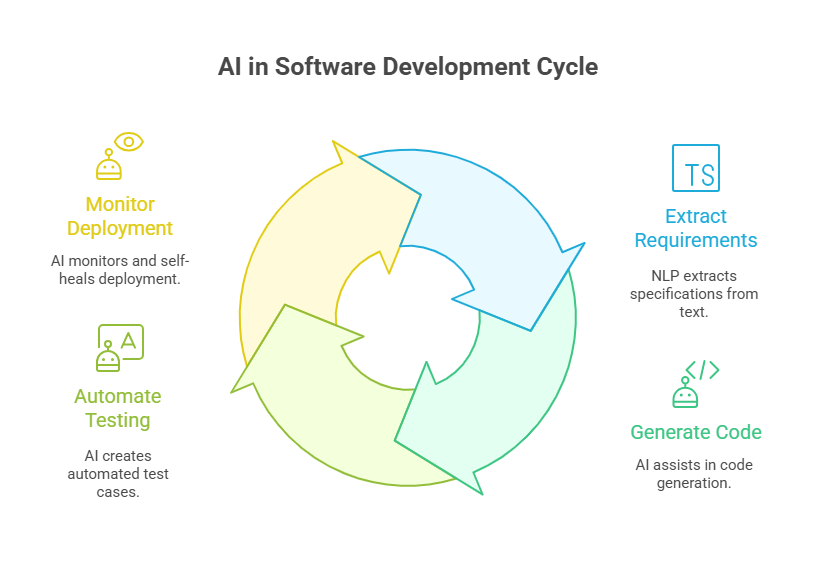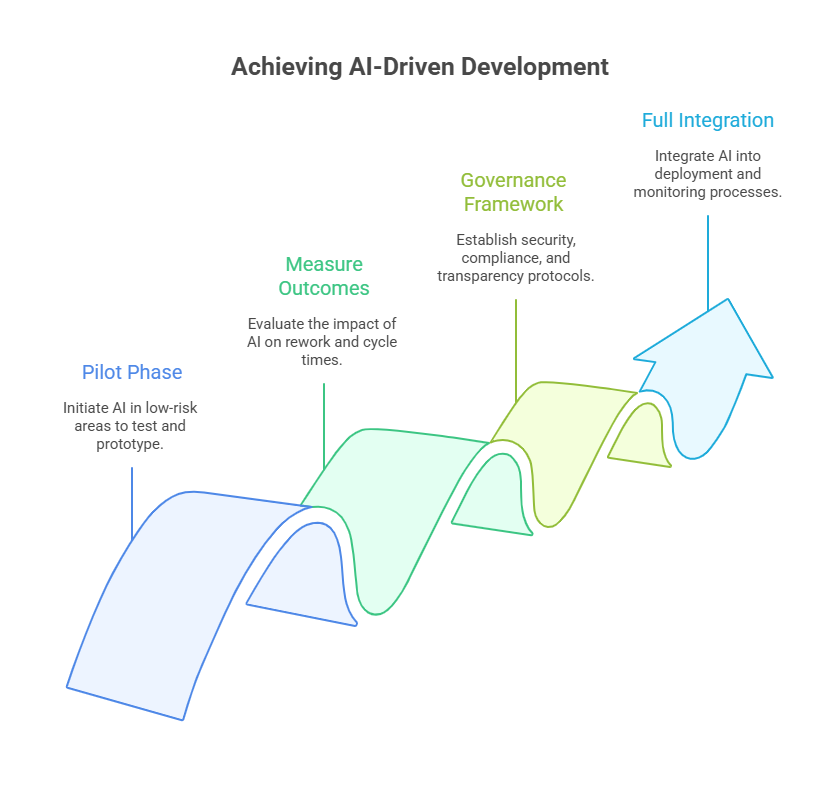Enterprise software once moved at the pace of code written entirely by hand. Teams spent months gathering requirements, building features, and reworking defects before an application reached production. That pace fails to match the demands of modern business today.
AI is redefining the process. What began as autocomplete for developers has matured into systems that generate code, design test cases, analyze requirements, and even predict failures before they occur. In a controlled study, developers using GitHub Copilot completed tasks 55.8% faster than those without assistance. McKinsey estimates that AI-enabled product development could create 2.6 to 4.4 trillion dollars in annual economic value.
Global enterprises are already adopting this shift. Banks, technology leaders, and SaaS providers use AI to accelerate delivery and reduce costs, proving that intelligent application development is no longer aspirational. It is becoming the foundation for faster ROI and continuous innovation.
Defining AI in Application Development
AI in application development goes far beyond automating repetitive tasks. It brings intelligence into every stage of the lifecycle, shaping how applications are designed, built, tested, and sustained. Instead of waiting for manual input, systems learn patterns, generate suggestions, and adapt continuously to context.
SAP frames this shift through three core technologies: machine learning, natural language processing, and generative AI. Together, they create a new foundation for software engineering. Machine learning models surface predictions from data that guide design and deployment decisions. Natural language processing allows requirements or test scenarios written in plain English to translate directly into technical specifications. Generative AI extends this further by producing code, user interface components, and test cases in seconds.
The impact is visible across four categories:
- AI-assisted coding and low-code generation where entire modules can be created faster than teams could draft boilerplate code.
- Intelligent quality assurance with test cases generated automatically and defects flagged before release.
- Predictive insights for design and deployment that shorten planning cycles and highlight risks in advance.
- Self-healing applications capable of monitoring performance, diagnosing issues, and fixing them without waiting for intervention.
This redefinition of development is what makes AI more than a productivity boost. It introduces a continuous intelligence layer that changes how software evolves over its lifetime.
Where AI Accelerates the Software Lifecycle
The influence of AI becomes most visible when mapped across the stages of the software development lifecycle. Each phase, from requirements gathering to post-deployment support, gains new speed and intelligence when AI is applied.

Requirements Gathering
Natural language processing allows requirements written in plain text to be analyzed and translated into technical tasks. This reduces ambiguity that often slows projects in their earliest stages. Teams move from lengthy documentation cycles to faster, more accurate alignment.
Coding and Low-Code Development
Generative AI tools can generate code snippets, user interface elements, and integration logic in minutes. This support enables developers to move faster and shift their focus to design choices and architecture, rather than repetitive boilerplate work.
Testing and Quality Assurance
AI creates test cases automatically, simulates usage patterns, and predicts likely points of failure. SAP reports productivity improvements of up to 75% in quality assurance workflows when AI is embedded into testing pipelines (SAP). Predictive defect detection reduces rework, ensuring that errors surface before release rather than after deployment.
Deployment and Maintenance
Once in production, AI shifts into predictive monitoring. AIOps platforms analyze logs and performance metrics in real time, flagging anomalies before they escalate. Some systems even perform self-healing actions, restarting services or reallocating resources without human intervention. These capabilities align well with the broader need for building resilient systems with strong DevOps observability, ensuring stability in modern distributed architectures.
By embedding intelligence into every step, AI transforms development into a faster and more adaptive process. The lifecycle becomes less about reacting to issues and more about anticipating them, which directly accelerates the path to measurable ROI.
From Speed to ROI: The Payoff of AI in Development
The first impact of AI in development is speed. Applications move from concept to release in shorter cycles because requirement analysis, coding, and testing happen in parallel with intelligent support. Faster delivery means businesses can launch products or features at the right moment instead of missing market opportunities, while also creating room for reducing churn and improving retention through smarter product engineering approaches.
Efficiency follows naturally. AI reduces the manual rework that drains time and resources, while predictive insights flag issues before they spiral into costly delays. Teams avoid the hidden expenses of patching production issues and instead focus their energy on building capabilities that add value.
The benefits extend well beyond the engineering floor. Applications released with greater stability create smoother business operations, fewer interruptions for end users, and stronger confidence in digital platforms. Customers experience fewer service disruptions, and internal teams can rely on systems that scale and adapt to demand without constant intervention.
There is also a cultural shift. When developers no longer spend hours on repetitive coding or routine bug fixes, their attention moves to design, innovation, and problem solving. That change fuels new ideas, accelerates experimentation, and improves employee satisfaction, which in turn helps retain talent in a competitive technology landscape.
Taken together, these shifts redefine the role of technology within the organization. Instead of being treated purely as a cost center, application development becomes a source of competitive advantage. The combination of faster delivery, higher quality, and continuous innovation translates into a return on investment that compounds over time.
Making AI-Driven Development a Reality
The shift toward AI in development often begins quietly. A single team experiments with automating test creation or using an assistant to generate boilerplate code. The productivity gains spark curiosity across the organization, and what starts as a side project soon becomes a conversation about scaling.
- Start with pilots that prove value: Introducing AI into requirements analysis, testing, or low-code prototyping shows results without heavy disruption. These are areas where teams can see immediate improvements in speed and quality, making it easier to build confidence in the approach. This is particularly valuable for early-stage teams experimenting with startup product development strategies, where time and resources are often limited.
- Anchor adoption to outcomes: AI initiatives succeed when tied to specific goals, such as cutting rework, reducing release delays, or increasing deployment frequency. Measurable outcomes help teams demonstrate impact and keep momentum going.
- Bring governance into the workflow: As AI generates code and makes predictions, questions of reliability, compliance, and security move to the forefront. Building checks and transparency into the workflow ensures adoption does not compromise trust.
- Expand in deliberate stages: Once initial pilots succeed, AI can move deeper into deployment optimization, predictive monitoring, and even self-healing systems. Scaling in stages avoids disruption and allows people and processes to adapt naturally.
- Shape a culture of partnership: AI works best when it is seen as an ally rather than an intrusion. Developers and testers who use AI to remove repetitive work free themselves to focus on design, architecture, and innovation. Over time, this cultural shift fuels both adoption and creativity.


